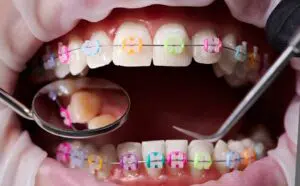Orthodontic treatment plays a crucial role in achieving a healthy and beautiful smile. Whether you’re wearing braces or aligners, the journey toward straighter teeth requires consistent care and attention. However, it’s important to remember that unexpected situations can arise during treatment, leading to orthodontic emergencies that require prompt action. To ensure you’re prepared for the unexpected, this article serves as a comprehensive guide to orthodontic emergencies and how to handle them effectively.
So, let’s delve into the world of orthodontic emergencies and learn how to be prepared for any unforeseen events that may arise during your orthodontic journey.
Understanding Orthodontic Emergencies
Definition of orthodontic emergencies
Orthodontic emergencies refer to unexpected situations or complications that require immediate attention or intervention during orthodontic treatment. These emergencies can arise due to various factors, such as accidental damage to orthodontic appliances, injuries to the mouth or face, or severe discomfort and pain.
Common types of orthodontic emergencies
Broken braces or wires:
One of the most common orthodontic emergencies is when braces or wires become damaged or break. This can happen due to external factors like eating hard or sticky foods, accidents, or even natural wear and tear over time.
Loose brackets or bands:
Another emergency situation occurs when brackets or bands become loose or detached from the teeth. This can cause discomfort and may affect the progress of your orthodontic treatment.
Pain or discomfort:
Orthodontic treatment can sometimes lead to temporary discomfort or soreness, especially after adjustments or the initial placement of braces or aligners. However, severe or persistent pain that hinders your ability to eat or speak could indicate an emergency.
Injuries to the mouth or face:
Accidents or injuries that result in trauma to the mouth or face may require immediate attention from an orthodontist or dentist, especially if the braces or aligners are affected.
Swelling or bleeding:
Swelling or bleeding in the mouth or gums should be taken seriously and evaluated promptly, as it could indicate an infection or other underlying issues that require urgent care.
Importance of identifying emergencies versus non-emergencies
Distinguishing between orthodontic emergencies and non-emergencies is vital to ensure appropriate actions are taken. While some issues may cause discomfort or inconvenience, they may not necessarily require immediate attention. However, certain emergencies, such as severe pain, injuries, or significant damage to orthodontic appliances, need to be addressed promptly to prevent further complications and maintain the effectiveness of the treatment.
Preparing for Orthodontic Emergencies
Finding an emergency orthodontist or orthodontic clinic
In the event of an orthodontic emergency, it’s crucial to have access to immediate professional assistance. Research and identify emergency orthodontists or orthodontic clinics in your area that offer prompt care for urgent situations. Keep their contact information readily available, including phone numbers and addresses, so you can reach out to them quickly when needed.
Keeping contact information readily available
Compile a list of essential contact information related to your orthodontic treatment. This should include your regular orthodontist’s contact details, emergency orthodontist or clinic information, as well as after-hours contact numbers if available. Store this information in your phone, write it down in a convenient location, or save it digitally for easy access during emergencies.
Understanding insurance coverage for orthodontic emergencies
Review your insurance policy or speak with your insurance provider to understand the coverage for orthodontic emergencies. Familiarize yourself with any specific requirements, limitations, or procedures you need to follow when seeking emergency orthodontic care. This knowledge will help you navigate the financial aspect of unexpected situations more effectively.
Assembling a basic orthodontic emergency kit
Prepare a basic orthodontic emergency kit to have on hand. Include items such as orthodontic wax, dental floss, cotton swabs, over-the-counter pain relievers (following the instructions provided), and a small mirror. These items can assist in temporary solutions and provide relief until you can see a professional. Consult with your orthodontist for specific recommendations on what to include in your emergency kit.
Handling Orthodontic Emergencies at Home
Broken braces or wires
If a brace or wire is broken or causing discomfort, use orthodontic wax to cover any sharp edges or protruding parts that may irritate your mouth. Avoid cutting or removing any parts of the braces yourself, as this can lead to further complications. Instead, contact your orthodontist as soon as possible to schedule an appointment for repair.
If you’re unable to see your orthodontist immediately, you can try using tweezers to gently push a protruding wire back into place. You can also use clean nail clippers to carefully clip a wire that is causing irritation but be cautious and only do so if you feel confident and it is necessary to alleviate discomfort temporarily.
Loose brackets or bands
If a bracket or band becomes loose but remains attached to the wire, you can use orthodontic wax to hold it in place temporarily. Apply the wax to the bracket or band to stabilize it until you can visit your orthodontist for proper reattachment.
Avoid eating hard, sticky, or chewy foods that can put additional strain on loose brackets or bands. Cut your food into smaller pieces and favor softer options to minimize the risk of further damage. Notify your orthodontist about the situation to schedule an appointment for repair.
Pain or discomfort
Rinse your mouth with warm saltwater to alleviate soreness and reduce inflammation. Over-the-counter pain relievers, such as acetaminophen or ibuprofen, can help temporarily relieve discomfort. Follow the instructions provided and consult with your healthcare professional if you have any concerns or specific medical conditions.
If the pain or discomfort persists or intensifies despite at-home remedies, it’s important to contact your orthodontist. They can evaluate the situation and provide appropriate guidance or recommend additional measures to address the issue effectively.
Injuries to the mouth or face
If you experience an injury to your mouth or face, such as a severe blow or accident, it’s crucial to seek immediate medical attention. Contact your orthodontist or dentist, explain the situation, and follow their instructions for emergency care. If necessary, visit the nearest emergency room for prompt treatment.
In cases where your regular orthodontist is unavailable, contact an emergency orthodontist or dentist who can provide the necessary care. Explain the nature of the emergency and follow their instructions for immediate assistance.
Seeking Professional Help
Identifying when professional assistance is necessary
While it’s possible to address certain orthodontic emergencies at home temporarily, it’s crucial to know when it’s time to seek professional help. Some signs that indicate the need for immediate professional assistance include:
- Severe pain that persists or worsens despite at-home remedies.
- Excessive bleeding or swelling in the mouth or gums.
- Injuries to the mouth or face resulting in significant trauma.
- Damaged orthodontic appliances that require professional repair or replacement.
- Any situation that causes difficulty in eating, speaking, or breathing.
If you experience any of these symptoms or are uncertain about the severity of your situation, it’s best to contact your orthodontist or an emergency orthodontic clinic for guidance.
Importance of timely action for orthodontic emergencies
Timely action is critical when it comes to orthodontic emergencies. Ignoring or delaying treatment can lead to complications, prolonged discomfort, or setbacks in your orthodontic progress. By seeking professional help promptly, you increase the chances of resolving the issue effectively and minimizing any potential disruptions to your treatment plan.
What to expect during an emergency orthodontic visit
During an emergency orthodontic visit, the orthodontist will assess the situation, examine your braces or aligners, and determine the appropriate course of action. They may repair or replace damaged appliances, provide pain relief, or take any necessary steps to address the emergency effectively. The orthodontist will also discuss any follow-up care or adjustments needed to ensure the continued success of your treatment.
Emergency Orthodontic Services: Trust Orthodontic Excellence for Immediate Care
Are you prepared for orthodontic emergencies? Don’t let unexpected situations catch you off guard. At Orthodontic Excellence, we understand the importance of being prepared and providing immediate care when emergencies arise during orthodontic treatment.
Our experienced orthodontists are ready to handle any orthodontic emergency with expertise and efficiency. Whether you experience a broken brace, loose wire, severe pain, or facial injury, our team is here to help.
Take the necessary steps to protect your oral health and ensure a smooth orthodontic journey. Contact us today to learn more about our orthodontic emergency services and how we can assist you. Don’t wait until it’s too late – be prepared for the unexpected and trust Orthodontic Excellence to be there for you when you need us the most.



 Puyallup
Puyallup